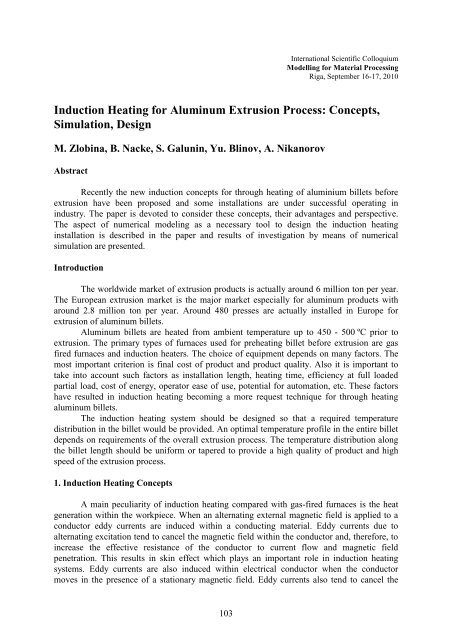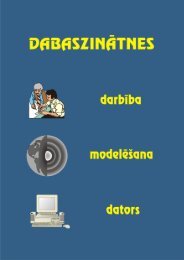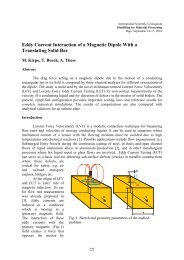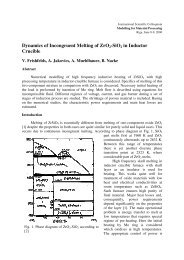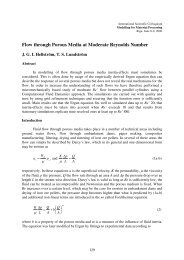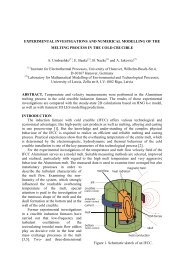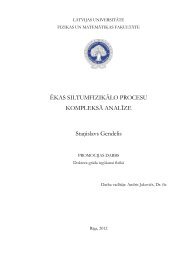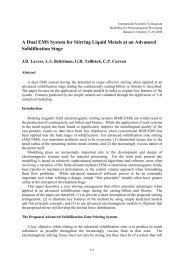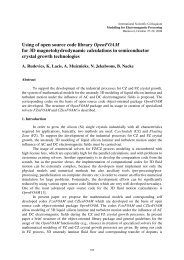Induction Heating for Aluminum Extrusion Process
Induction Heating for Aluminum Extrusion Process
Induction Heating for Aluminum Extrusion Process
Create successful ePaper yourself
Turn your PDF publications into a flip-book with our unique Google optimized e-Paper software.
International Scientific Colloquium<br />
Modelling <strong>for</strong> Material <strong>Process</strong>ing<br />
Riga, September 16-17, 2010<br />
<strong>Induction</strong> <strong>Heating</strong> <strong>for</strong> <strong>Aluminum</strong> <strong>Extrusion</strong> <strong>Process</strong>: Concepts,<br />
Simulation, Design<br />
M. Zlobina, B. Nacke, S. Galunin, Yu. Blinov, A. Nikanorov<br />
Abstract<br />
Recently the new induction concepts <strong>for</strong> through heating of aluminium billets be<strong>for</strong>e<br />
extrusion have been proposed and some installations are under successful operating in<br />
industry. The paper is devoted to consider these concepts, their advantages and perspective.<br />
The aspect of numerical modeling as a necessary tool to design the induction heating<br />
installation is described in the paper and results of investigation by means of numerical<br />
simulation are presented.<br />
Introduction<br />
The worldwide market of extrusion products is actually around 6 million ton per year.<br />
The European extrusion market is the major market especially <strong>for</strong> aluminum products with<br />
around 2.8 million ton per year. Around 480 presses are actually installed in Europe <strong>for</strong><br />
extrusion of aluminum billets.<br />
<strong>Aluminum</strong> billets are heated from ambient temperature up to 450 - 500 ºC prior to<br />
extrusion. The primary types of furnaces used <strong>for</strong> preheating billet be<strong>for</strong>e extrusion are gas<br />
fired furnaces and induction heaters. The choice of equipment depends on many factors. The<br />
most important criterion is final cost of product and product quality. Also it is important to<br />
take into account such factors as installation length, heating time, efficiency at full loaded<br />
partial load, cost of energy, operator ease of use, potential <strong>for</strong> automation, etc. These factors<br />
have resulted in induction heating becoming a more request technique <strong>for</strong> through heating<br />
aluminum billets.<br />
The induction heating system should be designed so that a required temperature<br />
distribution in the billet would be provided. An optimal temperature profile in the entire billet<br />
depends on requirements of the overall extrusion process. The temperature distribution along<br />
the billet length should be uni<strong>for</strong>m or tapered to provide a high quality of product and high<br />
speed of the extrusion process.<br />
1. <strong>Induction</strong> <strong>Heating</strong> Concepts<br />
A main peculiarity of induction heating compared with gas-fired furnaces is the heat<br />
generation within the workpiece. When an alternating external magnetic field is applied to a<br />
conductor eddy currents are induced within a conducting material. Eddy currents due to<br />
alternating excitation tend to cancel the magnetic field within the conductor and, there<strong>for</strong>e, to<br />
increase the effective resistance of the conductor to current flow and magnetic field<br />
penetration. This results in skin effect which plays an important role in induction heating<br />
systems. Eddy currents are also induced within electrical conductor when the conductor<br />
moves in the presence of a stationary magnetic field. Eddy currents also tend to cancel the<br />
103
magnetic field within the conductor and also alter the field outside the conductor. In<br />
additional, heat is generated, and J B <strong>for</strong>ces are induced within the conductor which<br />
impedes its motion. The high rotation speeds and powerful sources of fields are necessary to<br />
provide an effective heating using this approach.<br />
Classical induction through heating, where the alternating external magnetic field is<br />
applied to a conductor, is widely utilized <strong>for</strong> processes of the plastic de<strong>for</strong>mation in the non<br />
ferrous metallurgical industry.<br />
Mainly at aluminum extrusions plants longitudinal induction heating (LFH) is widely<br />
utilized to preheat aluminum billets be<strong>for</strong>e extrusion. Cylindrical solenoid multiturn induction<br />
coils are mostly often used in this application (Fig. 1). The conventional coils have very high<br />
energetic characteristics. Basically the electrical coil efficiency of LFH strongly depends on<br />
the frequency and the material properties of the workpiece. The power rating of the induction<br />
heaters ranges from several hundred kilowatts up to dozen megawatts. <strong>Aluminum</strong> is a lowresistive<br />
metal that makes possible to apply low frequencies. Utilizing low frequencies at 50 –<br />
60 Hz leads to such benefits as low capital cost of equipment and low energy consumption.<br />
From other hand the induction heating of low electrical resistive metals is known to have a<br />
low coil electrical efficiency. The efficiency of the conventional induction heater does not<br />
exceed 50 – 60 % because 40 – 50 % of total power is trans<strong>for</strong>med into heat in the copper<br />
windings and removed by the cooling water. The power losses in the coil windings is greater<br />
than all other losses of the induction heating system there<strong>for</strong>e reduction of losses in coil turns<br />
is a main way to improve the total efficiency of an aluminum billet heater.<br />
Multiturn<br />
coil<br />
Superconducting<br />
coils<br />
Rotation<br />
of billet<br />
Cryostat<br />
Billets<br />
Fig. 1. Conventional induction heating<br />
Shaft to<br />
motor<br />
Fig. 2. ALUHEAT concept<br />
To improve the process efficiency innovative induction techniques based on the<br />
phenomena of superconductivity have been proposed [1, 7]. The approach is based on<br />
generating a magnetic field by DC in superconductive coils (Fig. 2). Rotating of the billet in<br />
the DC magnetic field leads to the eddy current induction and heat generation in the billet.<br />
The induction system consists of two coils made from superconductive magnets and a billet<br />
placed between them so that the magnetic field is oriented perpendicular to the billet axis. The<br />
coils are placed in a cryostat to maintain a superconductor at a low temperature. The power<br />
loss in the system includes the losses in the electric motor to rotate the billet, losses in the<br />
cooling system and thermal losses from the billet surface. This approach should increase the<br />
electrical efficiency of the aluminum billet heater up to nearly 90 %. Actually different<br />
scientific groups have offered and investigated different shapes of the coils <strong>for</strong> this concept [2-<br />
6].<br />
A similar concept is meanwhile realized <strong>for</strong> use in industry and the installation<br />
operates actually in two companies <strong>for</strong> extrusion of aluminum billets and in one <strong>for</strong> copper<br />
104
illets [7]. The concept is operating with a superconducting coil as well. The magnetic flux is<br />
guided to the billet by a magnetic yoke and two billets can be heated simultaneously (Fig. 3).<br />
The efficiency of this system achieves 85%.<br />
HTS coil<br />
Magnetic yoke<br />
Magnets<br />
rotation<br />
Steel shell<br />
Rotating billets<br />
Isolation<br />
Billet<br />
Trough<br />
Permanent<br />
magnets<br />
Fig. 3. Energy concept<br />
Fig. 4. Permanent magnets concept<br />
Another concept is proposed to use permanent magnets instead of superconducting<br />
coils [8]. The permanent magnets are rotating and driven by an electric drive. This concept is<br />
actually under development and avoids a rotation of the heated billet. The billet is fixed in a<br />
ceramic trough or by axial clamping devices. Diameter of billets should not vary in a wide<br />
range because the air gap between the billet and permanent magnets should be small. For this<br />
concept electrical efficiency depends mainly on the efficiency of the motor and its driving<br />
system. Authors of the concept expect the system to achieve the same efficiency as <strong>for</strong><br />
ALUHEAT concept.<br />
The physical heating process <strong>for</strong> all concepts is similar. The optimal heating process<br />
needs an accurate design of coils or of permanent magnets. Mathematical modeling is a<br />
suitable tool <strong>for</strong> the optimal design of the heaters. In general strategy of the induction heating<br />
installation design consists of several steps, which are common <strong>for</strong> all engineering problems.<br />
The mathematical simulation involves transcribing an engineering description of the problem<br />
into well-defined mathematical statement, development of the model using numerical<br />
technique, <strong>for</strong> instance, finite-element method (FEM), which provides an approximate<br />
solution.<br />
2. Mathematical Modeling<br />
The induction heating is a complex combination of electrothermal processes. The<br />
electromagnetic and the thermal processes are described by differential equations with nonlinear<br />
coefficients. Non-linear regularities of the thermal process are the result of the fact that<br />
both thermo-physical properties of the materials and the intensity of heat exchange strongly<br />
depend on temperature of the workpiece. The mathematical description of the phenomenon<br />
requires to take into consideration the interrelated influence of different physical aspects so as<br />
electromagnetic, heat transfer and metallurgical.<br />
105
In general, Maxwell’s equation <strong>for</strong> electromagnetic field within the conducting<br />
material can be written as<br />
rot E B / t rot ( v B)<br />
,<br />
where E is electric field intensity, B is magnetic flux density and v is conductor velocity.<br />
The technique to obtain the solution <strong>for</strong> electromagnetic analysis depends on the way<br />
to solve Maxwell’s equations <strong>for</strong> the considered region taking into account geometry and<br />
material properties and boundary conditions.<br />
The temperature field in the workpiece is <strong>for</strong>med by several effects: distribution of<br />
Joule heat losses, temperature equalization by thermal conduction, thermal losses from the<br />
workpiece surface and mass transfer if there is a workpiece rotation.<br />
The choice of the technique <strong>for</strong> computation and analysis of the induction system<br />
parameters depends on the kind of the induction system, tasks and aims of investigation.<br />
Analytical methods realized with a computation code offer a very fast computation time, high<br />
accuracy and a compact easy way to input data. But the application area of these methods is<br />
restricted by simple geometry and linear physical properties of the materials. There<strong>for</strong>e<br />
analytical tools are considered to be a simplest tool <strong>for</strong> preliminary investigation of the<br />
system. Numerical tools allow a user to simulate any system geometry taking into account<br />
different nonlinearities. In case of the induction heating system the coupled solution of<br />
electromagnetic and thermal problems is necessary and should be organized as an iterative<br />
loop.<br />
At present different mathematical models to simulate the processes in the induction<br />
system <strong>for</strong> billet heating by rotation in DC magnetic field are available. Group of simplest<br />
tools is suitable <strong>for</strong> preliminary investigations of the system [3]. They are based on analytical<br />
techniques <strong>for</strong> calculation of electromagnetic processes in two dimensions and can be mainly<br />
used to optimize the integral characteristics of the heaters. The second group of models<br />
includes several specially developed numerical codes <strong>for</strong> calculation of two- and, especially,<br />
three-dimensional electromagnetic and thermal fields [2, 3].<br />
Numerous commercial software packages <strong>for</strong> computation of electromagnetic, thermal<br />
and mechanical processes in induction heating systems can be combined into the third group<br />
of models. They are suitable <strong>for</strong> both two- and three-dimensional analyses of different<br />
induction systems. However, high-power computers and skilled engineering staff are<br />
necessary <strong>for</strong> professional use of these tools.<br />
Nevertheless both electromagnetic and thermal analysis of the induction system <strong>for</strong><br />
billet heating by rotation in DC magnetic field requires building the full three-dimensional<br />
numerical model taking into account the rotation speed and all nonlinear physical properties<br />
of the materials.<br />
3. Design<br />
As mentioned above the aim of the induction heater design is to provide the required<br />
temperature distribution. Coil-billet geometry has a significant influence on the temperature<br />
distribution due to a distortion of the electromagnetic field in the ends of the billet. The<br />
temperature field in the billet is also <strong>for</strong>med by temperature equalization by thermal<br />
conduction and thermal losses from the billet surface.<br />
ALUHEAT concept has been deeply investigated by set of 2D and 3D numerical codes<br />
based on FEM [5, 9]. By means of the 2D model a lot of parameter studies have been carried<br />
out in order to investigate the influence of the rotation speed on the Joule heat and<br />
106
temperature distributions in the cross-section of the billet (Fig. 5, 6). The rotation speed<br />
influence has the similar physical process as <strong>for</strong> the conventional heating and with higher<br />
rotation speed the temperature becomes non-uni<strong>for</strong>m and the billet cross-section centre<br />
becomes colder than the billet surface. Finally frequency of 1000 rpm has been chosen as<br />
operating one to provide the balance of the low rotational <strong>for</strong>ces <strong>for</strong> the hot billet and the<br />
homogeneous temperature distribution.<br />
Fig. 5. Joule heat distribution at the rotation<br />
speed of 1000 rpm<br />
Fig. 6. Temperature distribution at the<br />
rotation speed of 1000 rpm<br />
Calculation results by means of 3D codes have shown that the temperature field in the<br />
billet is strongly inhomogeneous over the billet length. For considered induction system<br />
electromagnetic end effect results in overheating of the billet ends (Fig. 7). Design of a DC<br />
superconducting coil is very complicated to be adapted to the required heating process<br />
there<strong>for</strong>e independent measures from coil design have been considered in order to provide the<br />
required temperature profile in the billet [9].<br />
Fig. 7. Temperature distribution in the billet<br />
with the length of 600 mm without measures<br />
<strong>for</strong> uni<strong>for</strong>m temperature profile<br />
Fig. 8. Temperature distribution over the<br />
billet using magnetic rings<br />
The results of 3D numerical investigation have shown that the homogenous<br />
temperature profile (Fig. 8) can be obtained by means of special sets of the magnetic rings<br />
while the required tapered temperature profile has not been achieved by these measurements.<br />
The tapered profile can be achieved by shifting the coils to a certain angle from the billet. In<br />
this case the special mechanical tools can be arranged in the system.<br />
107
Conclusions<br />
Efficient concepts to reduce energy consumption <strong>for</strong> heating of aluminium billets are<br />
available. One concept is already under successful operation in industry. Other concepts offer<br />
additional advantages such as higher efficiency (ALUHEAT concept) and simple solution at<br />
lower cost (permanent magnet concept).<br />
Numerical modelling is the main tool to design any induction concept and to provide<br />
both high energetic parameters of the system and the required temperature profile. By means<br />
of developed numerical codes influence of different system parameters such as rotation speed<br />
and coils geometry has been investigated. Several concepts to control the temperature<br />
distribution in the billet have been proposed and analysed.<br />
Acknowledgment<br />
Financial support from the Ministry of Education and Science of Russian Federation in<br />
the frame of the Federal program «Scientific and scientific - pedagogical staff of the<br />
innovative Russia» <strong>for</strong> the years 2009-2013 is gratefully acknowledged.<br />
References<br />
[1] Runde, M., Magnusson, N.: <strong>Induction</strong> <strong>Heating</strong> of Aluminium Billets using Superconducting Coil. PHYSIC C,<br />
372-376, 2002, pp. 1339 134.<br />
[2] Fabbri, M., Morandi, A., Negrini, F.: Temperature Distribution in Aluminium Billets Heated by Rotation in<br />
Staic Magnetic Field Produced by Superconducting Magnets. COMPEL, Vol. 24, 2005, No.1, pp. 281 290.<br />
[3] Dughiero, F., Forzan, M., Lupi, S.: <strong>Induction</strong> heating of aluminium billets rotating in a DC magnetic field.<br />
Proceedings of the VII International Conference on Problems of Control and Modelling Complex System,<br />
Samara, 2006, pp. 171 176.<br />
[4] Magnusson, N.: Prospects <strong>for</strong> rotating billet superconducting induction heating. Proceedings of International<br />
Symposium on <strong>Heating</strong> by electromagnetic sources, Padua, 2007, pp. 479 486.<br />
[5] Nacke, B., Zlobina, M., Nikanorov, A., Ulferts, A.: Numerical simulation of induction heating of aluminium<br />
billets by rotation in DC magnetic field. Proceedings of International Symposium on <strong>Heating</strong> by<br />
Electromagnetic Sources, Padua, 2007, pp. 497 504.<br />
[6] Araneo, R., Dughiero, F., Fabbri M. and oth.: Electromagnetic and thermal analysis of the induction heating<br />
of aluminium billets rotation in DC magnetic field. Proceedings of International Symposium on <strong>Heating</strong> by<br />
Electromagnetic Sources, Padua, 2007, pp. 487 496.<br />
[7] Kellers, J., Bührer, C., Hagemann, H., Ostermeyer, B., Witte, W.: Magnetic billet heating rivals conventional<br />
furnaces. Heat <strong>Process</strong>ing, Vol. 8, 2010, No. 1, pp. 65–70.<br />
[8] Dughiero, F., Forzan, M., Lupi S. and oth.: A new high effective technology <strong>for</strong> the induction heating of non<br />
magnetic billets. Proceedings of International Symposium on <strong>Heating</strong> by Electromagnetic Sources, Padua,<br />
2010, pp. 531 538.<br />
[9] Zlobina, M., Nacke, B., Nikanorov, A.: Numerical modeling and investigation of coupled electro-thermal<br />
processes in induction heating <strong>for</strong> heating aluminum billets by rotation in DC magnetic field. Proceedings of<br />
the 6 th International conference on Electromagnetic processing of materials, Dresden, 2009, pp. 177 180.<br />
Authors<br />
Dr. Zlobina, Marina<br />
Dr. Galunin, Sergey<br />
Prof. Blinov, Yuri<br />
Department of Electrotechnology and<br />
Converter Engineering<br />
St. Petersburg State Electrotechnical University<br />
Prof. Popov Str. 5<br />
St. Petersburg, Russia<br />
E-mail: mvzlobina@eltech.mail.ru<br />
Prof. Dr.-Ing. Nacke, Bernard<br />
Dr.-Ing. Nikanorov, Alexander<br />
Institute of Electrotechnology<br />
Leibniz University of Hannover<br />
Wilhelm-Busch-Str. 4<br />
D-30167 Hanover, Germany<br />
E-mail: nacke@etp.uni-hannover.de<br />
108


